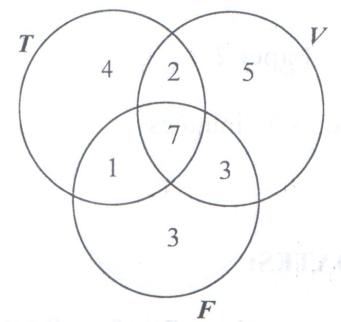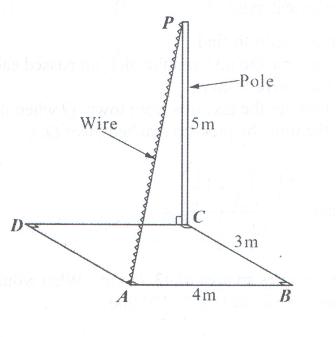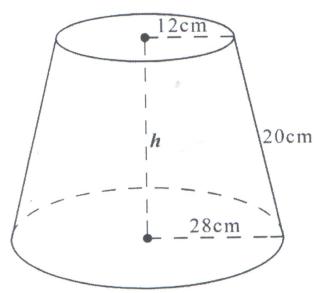Answer all questions in this section.
1. Given that h(x)=3x-2, find the value of
i). h(-2)
ii) x when h(x)=7
2. Josephine obtained 95% in a test which was marked out of 80 marks. How many marks did she score out of 80?
3. The Venn diagram below shows the number of students who play tennis (T), volleyball (V) and football (F).

Find
a) the number of students who play only one game.
b) n(V∪F ∩Tʹ)
4. A straight line passes through the points (-2, 5) and (2, -3). Determine the equation of the line.
5. The volume of sphere is 2000 cm3. Calculate the volume of a similar sphere whose radius is half of that of the given sphere
6. Given that
 find the values of a, b and c
find the values of a, b and c
7. The coordinates of points A and B are (-4, -5) and (x,y) respectively. The coordinates of the midpoint of line (AB) are (-3,1). Determine the values of x and y.
8. The position vectors of A and B are a and b respectively. A point X is on line (AB) such that 4 line(AX) =3 line(AB). Find the position vector of X, in terms of a and b.
9. An examination body pays its setters Shs 100,000 as basic fee and Shs8,000 for each question set. A withholding tax of 6% is deducted from a setter’s gross pay. Okot set ten questions. How much was his net pay?
10. The figure below shows a vertical pole, CP of height 5m standing on a rectangular horizontal slab ABCD. line(AB) = 4m and line (BC) =3m. PA is a wire that supports the pole.

Calculate the angle between the wire PA and the slab ABCD.
SECTION B
Answer any five questions from this section.
11. A group of 84 tourists were asked whether they had ever visited Gulu, Mbarara or Soroti. The number of tourists who had visited Gulu was equal to the number of tourists who had visited Mbarara. 54 had visited Soroti. 14 had visited Gulu and Mbarara only. 13 had visited all the three towns. 8 had not visited any of the towns.
a) Represent the given information on the Venn diagram
b) How many tourists had
i) visited Mbarara?
ii) not visited Gulu?
c) Given that a tourist is selected at random, what is the probability that the tourists had visited two towns only?
12. Towns P and Q are 100km apart. A pick-up starts from town P at 5.00am at a steady speed of 30km/h for 1 hour. It increases its speed to 100km/h until it reaches town Q. At 5.30am, a taxi starts from town Q towards P at a steady speed of 60km/h until it breaks down1 1⁄2 hours later.
a) On the same axes, draw distance – time graphs for the pick-up and the taxi.
(Use scale 2cm : 30 minutes on the horizontal axis and 2cm : 10km on the vertical axis)
b) Use your graphs to find
i) the time the taxi and the pick-up passed each other and how far they were from P
ii) how far the taxi was from town Q when it broke down.
iii) the time the pick-up reached town Q.
13. a) Evaluate

b) A lake occupies an area of 43.75km2. What would be its area in cm2, on a map whose scale is 1 : 250,000?
14. a) Given that T = {2, 5, 6, 8, 9, 10, 12, 13}, illustrate on papygrams the relations:
i) “Greater than by 3”
ii) “Factor of”
b) If f(x)=x+13 and g(x)= log10 (x+2)
Find
i) the value of x when f(x)=0
ii) gf(85).
15. a) A bank in a certain country buys and sells foreign currency as follows:
|
Currency |
Buying (Shs) |
Selling(Shs) |
|
1 US. Dollar ($) 1 Pound Sterling (£) |
2,900 4,650 |
3,000 4,700 |
A tourist arrived in that country with $4500. She converted all the dollars to shillings at the bank. During her stay she spent Shs 9,900,000 and then converted the remaining shillings to Pound Sterling. Calculate the amount she received in Pound Sterlings.
b) A generator is being sold in cash or on hire purchase. Its cash value is Shs 894000. On hire purchase, a deposit of 50% of the cash value is made and followed by equal monthly installments of SHS65000 for 8 months. Calculate the money saved when one buys the generator in cash rather than on hire purchase.
16. Given that

Find:
a) OR
b) i) PR
ii) |PR|
c) OS
17. The diagram below shows a lampshade made out of the lower part of a cone. The base radius is 28cm, the top radius is 12cm and the slant height is 20cm.
Calculate the;
a) height h, of the lamp shade.
b) surface area of the lampshade. (Use π=3.14)
